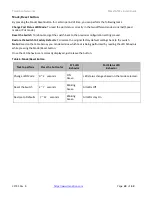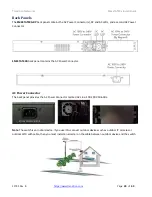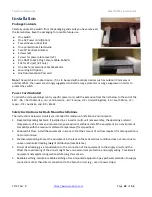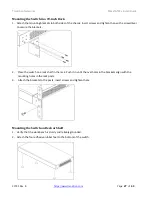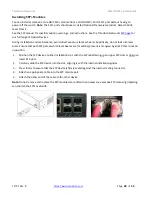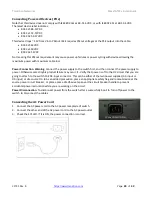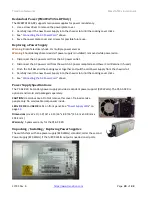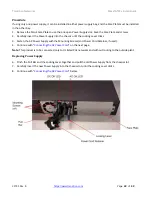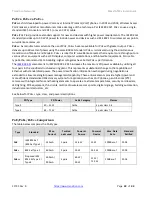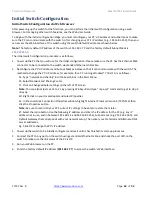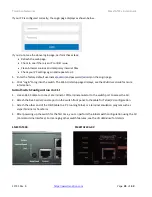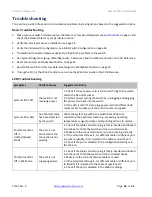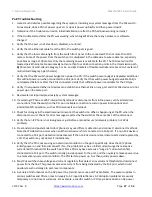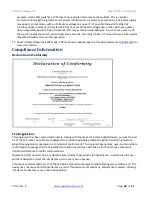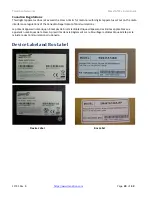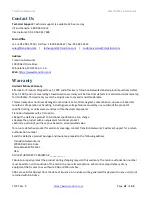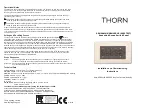
Transition Networks
SMxxTAT4Xx Install Guide
33785 Rev. B
Page
37
of
43
PoE Troubleshooting
1.
Get as much detail as possible regarding the symptom, including any system messages from the PoE switch.
For example, does a PD not power up at all, or does it power up briefly and then power down?
2.
Determine if the trouble occurred on initial installation or after the PD had been working normally?
3.
If the trouble started after the PD was working, what changed? Were there any hardware or software
changes?
4.
Verify that the port is not shut down, disabled, or errored.
5.
Verify that the Ethernet cable from the PD to the switch port is good.
6.
Verify that the total cable length from the switch front panel to the connected PD is not more than 100
meters. Some of the power from the switch port is dissipated in the cable due to wire resistance, especially
on cables as long as 100 meters. Only the remaining power is available to the PD. The 100-meter limit for
twisted-pair Ethernet cable assumes
a)
not more than four RJ-45 connection points in the transmission path,
b)
90 meters of solid-strand Category 5 or 5e, and
c)
10 meters of flexible multistrand cable (2-to-5 meters of
multistrand Category 5 patch cords).
7.
Verify that the PSE switch power budget can power the PD. If the switch power budget is depleted, additional
PDs will not power-on when connected to a PoE port. Verify that the switch power budget (available PoE) is
not depleted before or after the PD is connected. Verify that sufficient power is available for the PD type.
8.
Verify if non-powered Ethernet devices can establish an Ethernet link on any port and that PoE devices do not
power up on the same port.
9.
Review alarms reported previously by system messages.
10.
If a working IP Phone or WAP intermittently reloads or disconnects from inline power, verify all electrical
connections from the switch to the PD. An unreliable connection results in power interruptions and
intermittent PD operation, such as PD disconnects and reloads.
11.
Check for changes in the electrical environment at the switch site. What is happening at the PD when the
disconnect occurs? Check for error messages reported by the switch at the same time of the disconnect.
12.
Verify that an IP Phone is not losing access just before a reload occurs (a network problem, not a PoE
problem).
13.
Pre-standard and post-standard VoIP phones may use different detection and connect / disconnect methods.
Note that PD detection occurs when an Ethernet device is first connected to a PoE port. If a non-PoE device is
connected to a PoE port, detection is deactivated. If the non-PoE device is later disconnected and replaced by
a PD, the switch may not detect it immediately.
14.
Verify that the PD is not causing an overcurrent condition on the port. Specifically: does the VoIP phone
initially power on and then disconnect? If so, the problem may be an initial current surge that exceeds a
current-
limit threshold for the switch port. Some PDs may have excessive “surge in” current when first
connected to a PoE port. The switch initially provides power to the port, and then quickly removes power due
to a momentary overcurrent condition. The PD starts to power up, but then quickly powers down.
15.
Most PoE switches have voltage and current regulators that detect an overcurrent threshold and disconnect
power from the line. This prevents excessive current from being delivered by the PoE port, which could
possibly result in damage to port-level components.
16.
A variety of disturbances on the AC power line (mains) can cause odd PoE problems. The power supplies in
various switches and PDs can react uniquely to AC input disturbances. AC disruption problems are usually
temporary or one-time occurrences. For example, a specific switch or PD may reboot due to an AC power

